Historical photographic records show a clear deterioration of the Opuntia echios forests on South Plaza island. The breakdown of ecological integrity on South Plaza is why the Galapagos Verde 2050 project (GV2050) works to restore this cactus population, using water-saving technology to accelerate the process of restoration. This April 2019, GV2050 travelled to the island and spent five days continuing the restoration of this keystone endemic species.
“We need to understand both the 'natural' and the 'wild' in such a way that we can imagine giving more to the world around us than the gift of our mere absence.”
John Visvader, 1996
This quote speaks volumes when I consider the ecosystems of the Galapagos and decision we make, as conservationists, to intervene in their extant fragility. The magnitude of ecological disruption that has come from the arrival of humans and invasive species in Galapagos is irreversible without intervention. This is why the GV2050 project of the Charles Darwin Foundation works on South Plaza island to accelerate the process of ecological restoration with the emblematic Opuntia echios var. echios — one of the endemic Galapagos prickly pear cactus species.
South Plaza island lies east of Santa Cruz island, and covers around 13 hectares of Galapagos National Park land. The island once boasted an impressive landscape of Opuntia dotted amongst curious land iguanas and vibrant red Sesuvium. In 2018, the Galapagos archipelago received an all-time high of 275,817 tourists (GNPD, 2018) and the biological wonder of South Plaza make it one of the most visited tourist sites of the islands, experiencing a daily influx of cruise ship passengers and tours from Santa Cruz.
The Galapagos Hawk (Buteo galapagoensis), land iguana (Conocephalus subcristatus) and Opuntia echios together form a key food chain on the island (Christian & Tracy, 1980; de Vries, 1989). The 1920’s and 30’s human settlement in Santa Cruz subsequently caused the extinction of the hawk from Santa Cruz, and a poaching ban was placed on land iguanas. Together this caused a disproportionate growth of the land iguana population. The Opuntia fruits and cladodes that fall from the adult plants are being eaten by the iguanas at a faster rate than they can establish as new plants, and this is likely the primary cause of decline in the Opuntia population over previous decades (Jaramillo, Tapia, & Gibbs, 2017; Sulloway & Noonan, 2015). The population decline has also been linked to the introduction of house mice and harsh El Niño weather events (Campbell et al. 2012; Snell et al. 1994). This is why GV2050 aims to restore the population of Opuntia to historic numbers (Jaramillo et al., 2017).

With the support of the Galapagos National Park Directorate (GNPD), in the first week of April 2019, the GV2050 team returned to South Plaza to continue the conservation work of the project. Despite the change in landscape colour with the new season, the island remained a pleasant and familiar sight. We spent five days monitoring the plants, replacing the protective fencing, and transporting water to the Groasis water-saving technology boxes for refilling. I noticed that seven months of being on this project has significantly improved my chimbuzo carrying skills! The protective fencing, although unfitting against the natural backdrop of the island, is necessary to stop the growing cacti from being eaten by land iguanas.
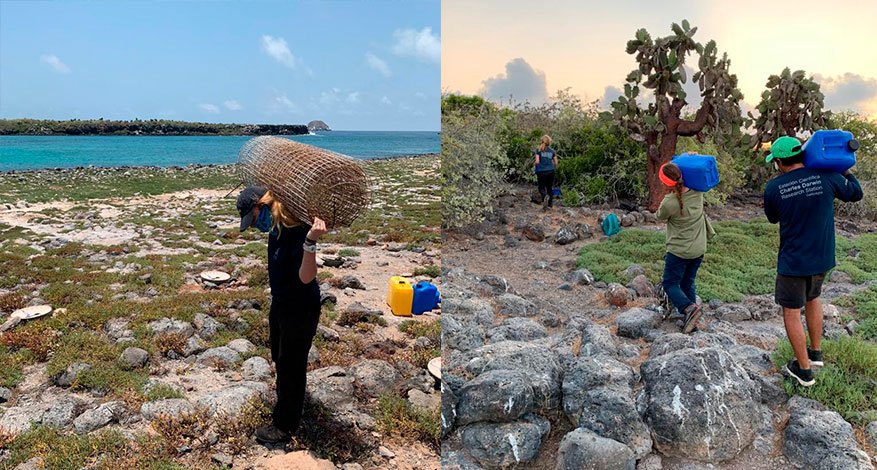
The monitoring continues to show promising results, with impressive growth of the seedlings and cladodes. Since the first planting in 2014, GV2050 has more than doubled the population of Opuntia echios on the island.
In addition to this, the trip provided many exciting observations. First and foremost, we noticed our work was being done under the watchful eye of a Galapagos Hawk, which a local guide told us had been there for around a month! It was not only a special experience to see one of these endemic species, but may also be a positive indicator of the ecological integrity that is returning to the island. Although GV2050 has been dedicated to the restoration of this island since the pilot project lead by Patricia Jaramillo in 2013, the process of ecological restoration is slow and the field conditions for these trips are extreme. So, to see this hawk is a huge reminder for not only the GV2050 team, but to all our collaborating institutions such as the GNPD, as to why we continue to put our hearts into the work of this long-term project.
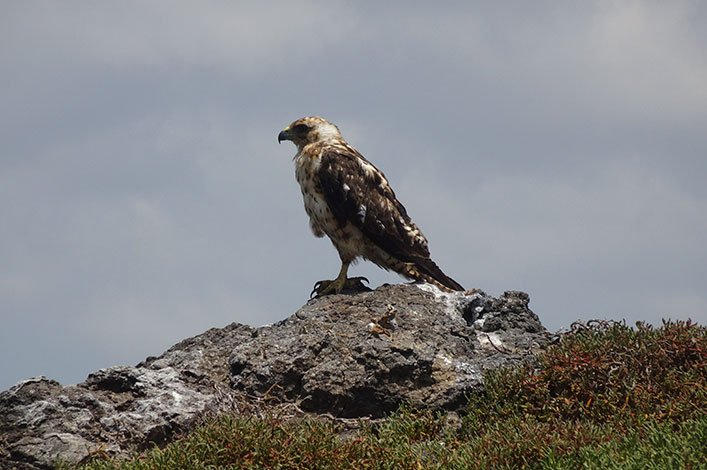
On previous trips, we have collected iguana excrements from which we extracted Opuntia seeds, and grown these for two years in our CDF laboratory. However, it is also possible to plant the cladodes of adult plants directly. Cladodes are the parts of the adult cactus that are often mistaken as the ‘leaves’ of the cactus, when actually the spines of the cactus are the leaves, and cladodes are vegetative bud that can sprout to allow asexual reproduction.
The advantage to this method with cladodes is that it provides a much faster means of restoration, because the cladodes are in a later stage of development. However, planting cladodes does not provide the same degree of genetic variability that would help the strengthen the population in the long-term. This is why GV2050 works with both of these methods for ecological restoration. Whilst there, we spent an afternoon removing cladodes from adult cacti to then plant three days later using the water-saving technologies Groasis and Hydrogel (Hicks and Mauchamp 2000; Coronel 2002). This is one of two methods this project has for planting new individuals on South Plaza.
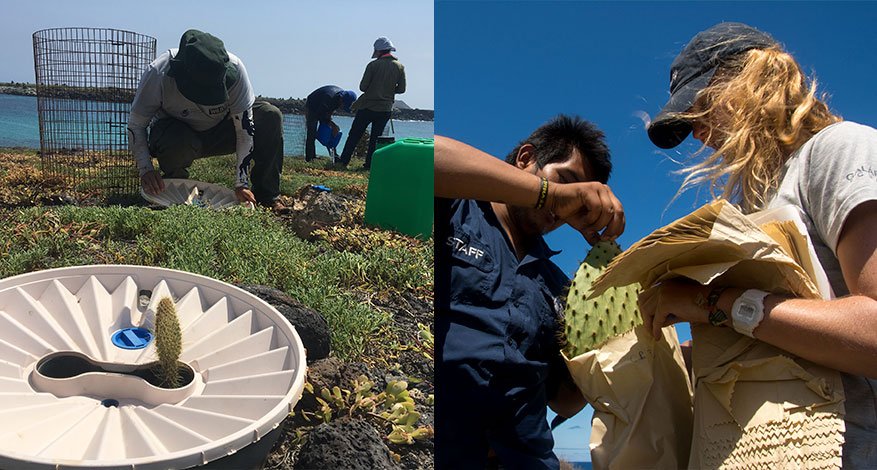
Despite the much hotter weather and many more mosquitos, South Plaza continues to be my favourite island to work on. When you look out over the island, it is easy to picture the return of the Opuntia forest there once was. For me, it brings a great sense of pride to think that the scientific work I am doing as part of the GV2050 project is contributing to this, and ensuring the continuation of this island’s beauty.
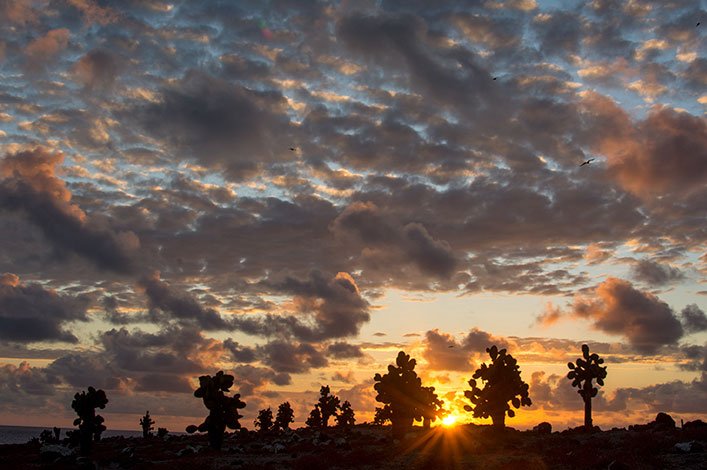
GV2050 project is implemented in collaboration with the Charles Darwin Foundation and Galapagos National Park Directorate. The project is financially viable thanks to the support of the COmON Foundation, The Leona M and Harry B. Helmsley Charitable Trust and the BESS Forest Club. We would like to also extend our thanks to the Isabela II, Galaxy II, Sea Finch, OceanSpray and Rolf Wittmer tourism cruise ships for the support given to the work of GV2050 during the trip and supporting conservation in the Galapagos, and finally to Patricia Jaramillo Díaz for her helpful insights, edition and comments.
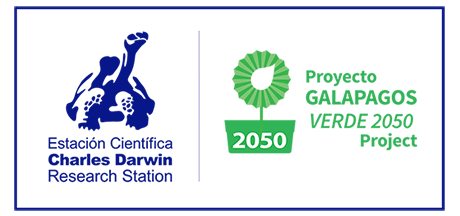
Bibliography
Campbell K, Aguilar K, Cayot L, Carrión V, Flanagan J, Gentile G, Gerber G, Hudson R, Iverson J, Llerena F, Ortiz-Catedral L, Pasachnik S, Sevilla C, Snell H, Tapia W (2012) Mitigación para la iguana terrestre de Galápagos (Conolophus subcristatus) durante la aplicación aérea de cebos de brodifacoum con base cereal en la Isla Plaza Sur, Galápagos, para la erradicación del ratón (Mus musculus) v4.0.:1-25.
Christian, K. A., & Tracy, R. (1980). Santa Fe Island since the Eradication of Feral Goats. In Noticias de Galapagos (Vol. 31, p. 16). Charles Darwin Foundation.
Coronel V (2002) Distribución y Re-establecimiento de Opuntia megasperma var. orientalis Howell. CACTACEAE) en Punta Cevallos, Isla Española–Galápagos. Universidad del Azuay, 78 pp.
de Vries T (1989) Conservation, status and ecological importance of the Galapagos hawk Buteo galapagoensis. Meyburg, B U & Chancellor, RD [Eds] Raptors in the modern world World Working Group on Birds of Prey and Owls, Berlin, London & Paris
DPNG. (2018). Informe anual de visitantes a las áreas protegidas de Galápagos del año 2018. Galápagos - Ecuador.
Hicks DJ, Mauchamp A (2000) Population structure and growth patterns of Opuntia echios var. gigantea along an elevational gradient in the Galápagos Islands. Biotropica 32 (2):235-243
Jaramillo Díaz, P., Tapia, W., & Gibbs, J. (2017). Action Plan for the Ecological Restoration of Baltra and Plaza Sur Islands. Galápagos - Ecuador.
Snell, H. M., Snell, H. L., & Stone, P. (1994). Accelerated mortality of Opuntia on Isla Plaza Sur: another threat from an introduced vertebrate? Noticias de Galapagos, 53(April), 19–20.
Sulloway, F. J., & Noonan, K. (2015). Opuntia Cactus Loss in the Galapagos Islands, 1957-2014 (Pérdida de cactus Opuntia en las Islas Galápagos, 1957-2014). 2015(January), 1–30.




